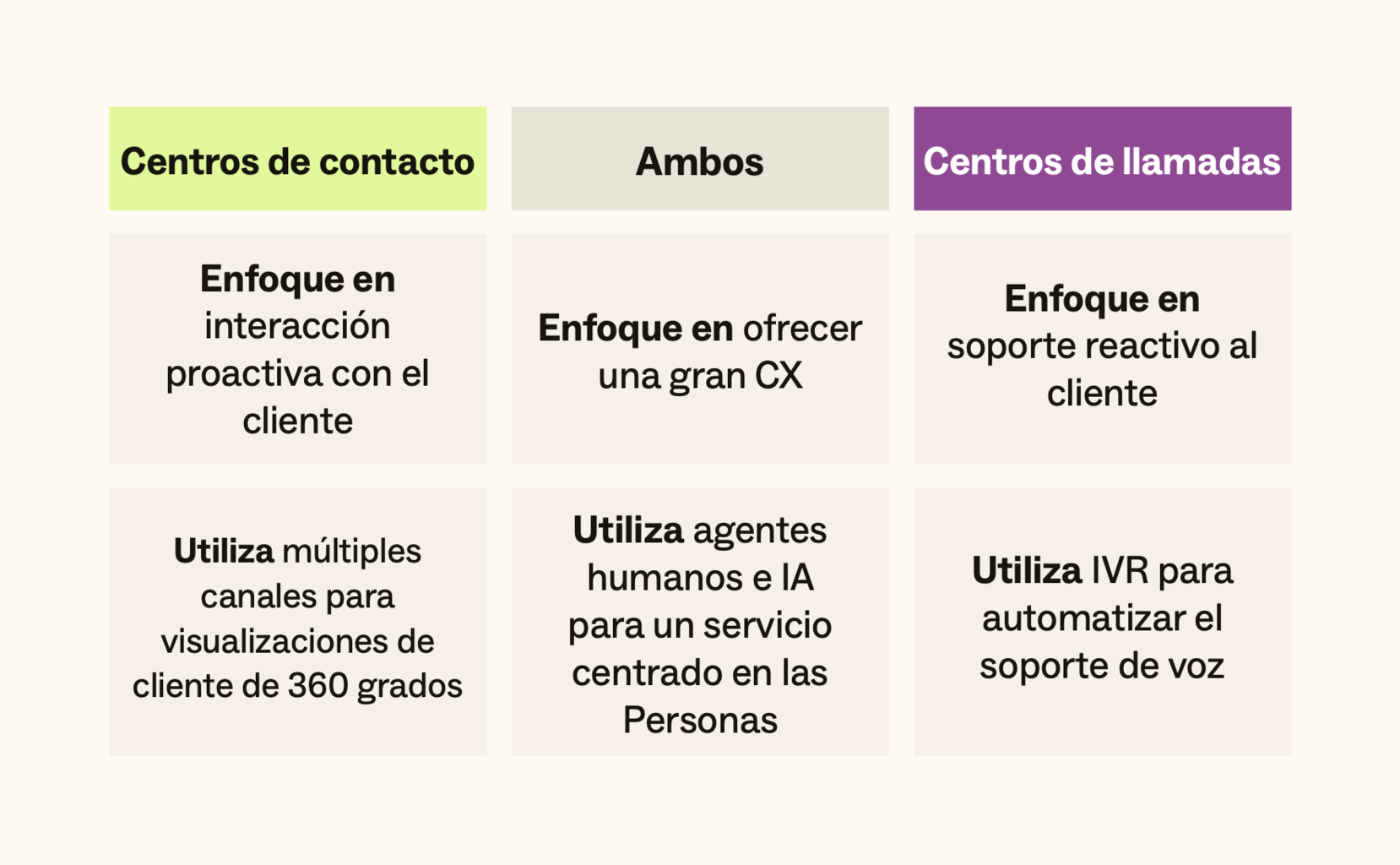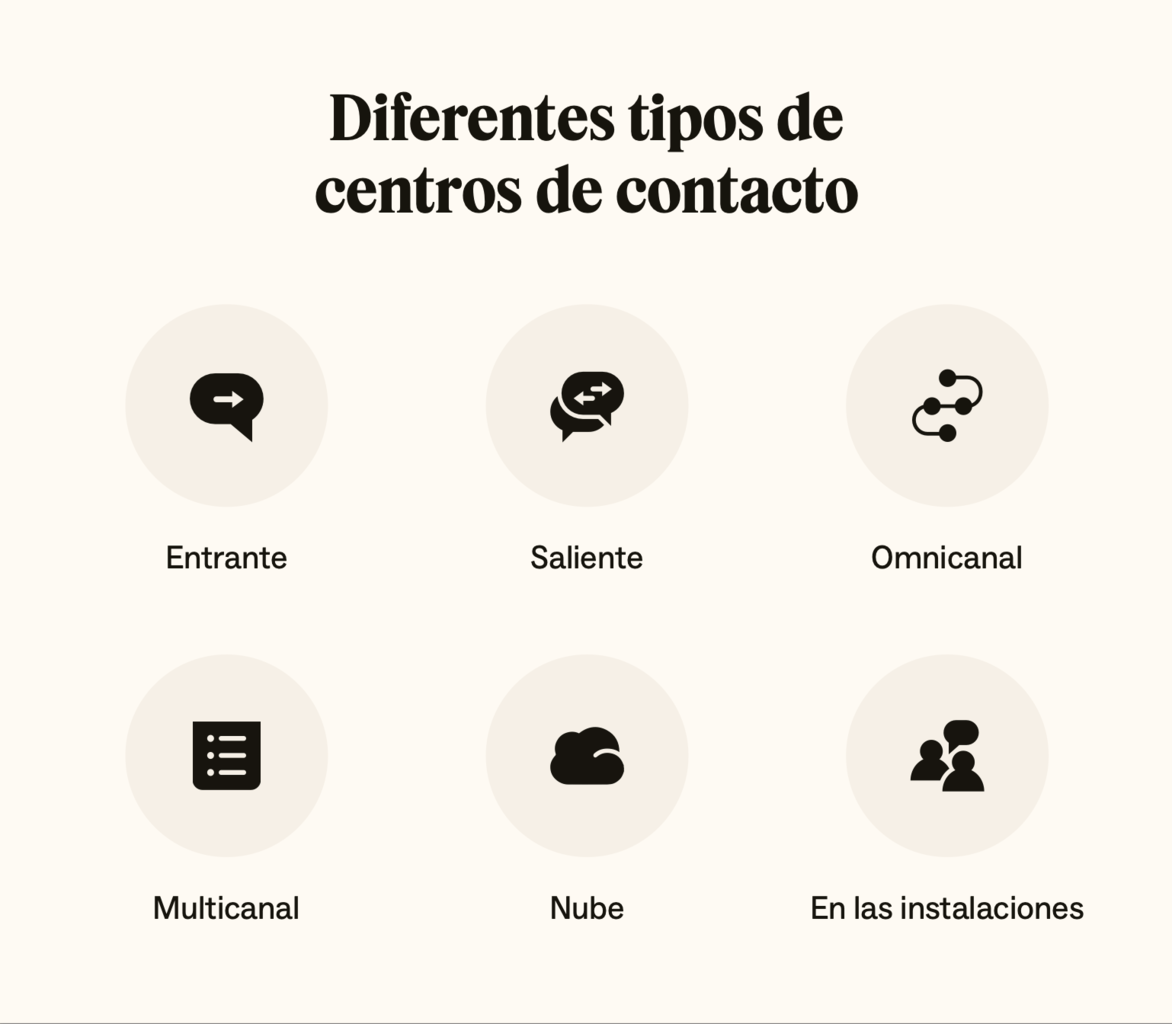Artículo • 8 min read
¿Qué es un centro de contacto? Definición, tipos, y casos de uso
Establezca un centro de contacto flexible y dinámico para impulsar la lealtad del cliente y mejorar la eficiencia de los agentes.
Cristina Maza
Escritora colaboradora
Última actualización en 19 julio 2025
¿Qué es un centro de contacto?
Un centro de contacto es un Departamento que gestiona la interacción con el cliente a través de múltiples canales, como redes sociales, correo electrónico, voz y chats Conectado. El término también puede referirse al Software que el equipo utiliza para manejar esas interacciones. El software de centro de contacto puede guardar y consolidar información contextual de las conversaciones con los clientes, lo que permite a las empresas ofrecer experiencias personalizadas y omnicanal.
Los consumidores se comunican a través de varias vías—desde servicios de mensajería hasta aplicaciones y correo electrónico. Sus elecciones de canales de comunicación no siempre son previsibles. Entonces, si solo ofreces uno o dos canales de atención al cliente, perderás oportunidades críticas para conectar con tu Audience.
Establezca un centro de contacto moderno y dinámico para reunirse con sus clientes con soporte centrado en el ser humano cuando y donde lo necesiten. Los centros de contacto te permiten conectarte con los clientes a través de sus canales de comunicación preferidos y proporcionan las herramientas que ayudan a tus agentes a desempeñarse a su Full potencial.
Sigue leyendo para aprender todo lo que necesitas saber sobre los centros de contacto, desde cómo funcionan hasta consejos sobre cómo implementar y gestionar el tuyo propio.
Más información en esta guía:
- Cómo funciona un centro de contacto
- Centro de contacto vs. centro de llamadas
- 6 tipos de centros de contacto
- 5 beneficios de un centro de contacto
- Principales casos de uso de un centro de contacto
- Tecnología clave de centro de contacto y destacar
- Cómo administrar una estrategia de centro de contacto
- El futuro de los centros de contacto
- Preguntas frecuentes
- Prepárate para el futuro de tu CX con software para centros de contacto
Cómo funciona un centro de contacto
A diferencia de los centros de llamadas tradicionales que principalmente manejan llamadas telefónicas, los centros de contacto utilizan tecnología como IA y automatización para agilizar las conversaciones y asegurar un servicio rápido y personalizado. Estos centros son capaces de ofrecer soporte autónomo e hiper-Personalizado, fortaleciendo la atención al cliente, ventas y más. Ayudan a las empresas a fortalecer las relaciones con el cliente mientras empoderan a los agentes para trabajar de manera más eficiente.
Una de las maneras clave en que operan los centros de contacto es distribuyendo inteligentemente las solicitudes entrantes:
- Agentes de IA y respuesta de voz interactiva (IVR) preseleccionan las consultas de los clientes para dirigirlas al agente más adecuado o proporcionar respuestas automatizadas instantáneas a preguntas sencillas.
- Análisis en tiempo real rastrean el volumen de llamadas, los tiempos de espera y la percepción del cliente, permitiendo que los supervisores ajusten el personal y los flujos de trabajo en el momento.
- Información valiosa impulsada por IA ayuda a los agentes sugiriendo respuestas, detectando emociones a partir de percepción del cliente y marcando Tickets Urgentes, haciendo que cada interacción sea más efectiva.
- Copilotos de IA pueden proporcionar recomendaciones de script en tiempo real, mostrar datos del cliente relevantes y resumir interacciones pasadas para que los agentes no pierdan tiempo buscando en los registros.
Ejemplo: Si un cliente cambia de chat a una llamada telefónica, la IA asegura que el agente tenga el contexto completo, evitando repeticiones frustrantes. Al manejar Tareas rutinarias, la IA libera a los agentes para que se enfoquen en problemas complejos o emocionalmente sensibles. |
En última instancia, los mejores centros de contacto combinan IA de vanguardia con un enfoque centrado en las Personas. La automatización acelera las resoluciones, mientras los agentes utilizan información valiosa de IA para personalizar las interacciones y construir una buena relación. Este saldo lleva a clientes más felices, menos agotamiento de agentes, y operaciones más eficientes.
Centro de contacto vs. centro de llamadas
Los centros de llamadas exitosos y los centros de contacto pueden tener responsabilidades que se superponen, pero existen diferencias claras entre ambos.

El software de centro de llamadas solo gestiona llamadas, dirigiéndolas a diferentes departamentos, a menudo con la ayuda de un Protocolo de Voz sobre Internet (VoIP) empresarial. Sin embargo, un centro de contacto ofrece a los clientes múltiples canales de soporte, incluidos teléfono, correo electrónico, chat, aplicaciones de mensajería, redes sociales y opciones de autoservicio.
Gracias a estas opciones de comunicación ampliadas, un centro de contacto puede servir mejor a sus clientes, ayudándole a ofrecer experiencias del cliente mejoradas.
| Centro de contacto | Centro de llamadas |
Canales de comunicación |
|
|
Opciones de autoservicio |
|
|
Funcionalidad |
|
|
6 tipos de centros de contacto
Aprende sobre los diferentes tipos de centros de contacto para determinar la opción adecuada para tu empresa y clientes.

Servicios y características clave del centro de contacto
Es importante personalizar su centro de contacto para satisfacer las necesidades de sus clientes, al mismo tiempo que se adhiere a las limitaciones de presupuesto y recursos. Las características clave de los centros de contacto varían según el Software pero pueden incluir:
- Sistemas de respuesta de voz interactiva (IVR): IVR es un sistema de árbol de llamada que respuestas llamadas entrantes y ruta al cliente a su Departamento elegido o al agente más adecuado.
- Distribución automática de llamadas (ACD) y enrutamiento: Los sistemas ACD enrutan las llamadas entrantes a agentes disponibles para reducir los tiempos de espera.
- Grabación de la llamada: Las llamadas de clientes se graban para medidas de control de calidad y se utilizan para el entrenamiento de agentes.
- Monitoreo de llamadas: Los gerentes pueden rastrear la actividad desde un panel en tiempo real y escuchar las llamadas en curso.
- Informes en tiempo real: Los equipos pueden acceder a informes con información actualizada para adaptarse proactivamente a las necesidades del cliente y resolver problemas de servicio.
- Integraciones: Los centros de contacto pueden conectarse a herramientas de terceros para que los equipos puedan trabajar de manera eficiente y acceder a todos los recursos de la empresa.
5 beneficios de un centro de contacto
Con un centro de contacto, los agentes de soporte pueden conectarse con los clientes a través de varios canales. Esta flexibilidad no solo es conveniente para los clientes—también significa que hay más oportunidades para conocer a tu Audience y practicar atención al cliente. Aquí hay cinco beneficios clave que su negocio puede experimentar al usar un centro de contacto.

1. Ofrece soporte omnicanal
Los agentes pueden proporcionar mejor soporte cuando tienen una imagen completa del cliente y el problema. Los centros de contacto omnicanal consolidan la información del cliente reunida a través de chatbots, formularios y representantes en un solo lugar.
Supongamos que un cliente Reach solicita ayuda y se comunica con un chatbot. Después de responder una serie de preguntas automatizadas, el Ticket de soporte del cliente se escala a un agente en vivo. Para este momento, el cliente tiene poca o ninguna paciencia y no quiere repetirse a un representante. Afortunadamente, con un sistema de soporte omnicanal, el agente ya tiene la información del cliente y el contexto de su problema, ayudando a agilizar el resto de la interacción.
Ejemplo: Supongamos que un cliente Reach solicita ayuda y se comunica con un chatbot. Después de responder una serie de preguntas automatizadas, el Ticket de soporte del cliente se escala a un agente en vivo. Para este momento, el cliente tiene poca o ninguna paciencia y no quiere repetirse a un representante. Afortunadamente, con un sistema de soporte omnicanal, el agente ya tiene la información del cliente y el contexto de su problema, lo que ayuda a agilizar el resto de la interacción. |
2. Mejora la satisfacción del cliente
Los centros de contacto pueden mejorar la satisfacción del cliente porque los clientes pueden elegir la forma de comunicación que mejor atienda sus problemas. También ayudan a los agentes a optimizar interacciones con el cliente y a basarse en comunicaciones anteriores utilizando la información recopilada previamente. Esto permite experiencias más personalizadas y, en última instancia, resulta en relaciones de consumidores más sólidas y mayor satisfacción del cliente.
Ejemplo: Supongamos que un cliente necesita ayuda inmediata con un problema de alta importancia. Es posible que prefieran hablar con un agente por teléfono para abordarlo. Mientras tanto, un cliente con una consulta de baja importancia podría Reach a través de correo electrónico o chat. De cualquier manera, los centros de contacto empoderan a los clientes con opciones, incluyendo opciones de autoservicio. |
3. Promueve la colaboración
Al consolidar las interacciones con el cliente y consultas en un centro centralizado, los equipos del centro de contacto tienen acceso a un sistema unificado y organizado para abordar los problemas del cliente. Esta centralización facilita la comunicación del equipo, permitiendo a los agentes colaborar efectivamente y compartir información valiosa, soluciones y mejores prácticas.
La resolución de problemas es más eficiente porque los agentes pueden recurrir a una base de conocimiento colectiva, lo que facilita proporcionar respuestas consistentes y precisas. Este entorno colaborativo mejora la cohesión del equipo y asegura un servicio de calidad, beneficiando a los clientes y a la organización.
Ejemplo: Imagine un agente de servicio de atención al cliente recibiendo un Ticket por una disputa de facturación compleja de un cliente corporativo de larga data. El agente se conecta tanto con el analista senior del Departamento de facturación como con el lead del equipo de gestión de cuentas con la Plataforma de centro de contacto integrado de la empresa. El equipo multifuncional resuelve el problema en una hora e identifica una mejora sistémica en el proceso de facturación. |
4. Aumenta las oportunidades de ventas.
A diferencia de los centros de llamadas, los centros de contacto incluyen tanto canales Conectados como el teléfono. La comunicación multicanal activa más oportunidades para aumentar los ingresos que solo usar teléfonos. Los agentes pueden realizar ventas adicionales y ventas cruzadas de productos o servicios, como enviar enlaces a productos que resuelven el problema de un cliente o compartir información sobre una actualización de paquete.
Ejemplo:Durante una llamada rutinaria de servicio al cliente sobre la garantía de una laptop, un agente de soporte técnico nota que el cliente está teniendo dificultades con equipo Obsoleto. El agente reconoce la oportunidad y explica los últimos modelos de la empresa para abordar las necesidades del cliente. Al final de la llamada, el cliente recibe un servicio excepcional y compra tres computadoras portátiles nuevas con planes de servicio extendido. Un centro de contacto ayudó a convertir una simple interacción de soporte en una oportunidad de ventas significativa que beneficia tanto al cliente como a la empresa. |
5. Gather información valiosa sobre el cliente
Los centros de contacto Activar a los agentes para conectarse con clientes en varios puntos de contacto, obteniendo información valiosa sobre necesidades del consumidor, preferencias y comportamientos de compra.
El Software de análisis puede rastrear y medir las principales métricas de experiencia del cliente en todos los canales. Puedes usar estos datos para investigar frases y palabras de moda en las conversaciones con clientes, lo que puede ayudarte a detectar problemas antes de que se agraven.
Además, el software de análisis entre canales puede ayudarte a interpretar datos de todos los canales, obtener una vista de cliente de 360 grados y determinar cuáles son los canales de comunicación que más le gustan a tu Audience. Puedes usar esta información para segmentar a tus compradores y adaptar tu atención al cliente en consecuencia.
Ejemplo: Un centro de contacto de un banco podría notar que los clientes se quejan de una “estafa de tarjeta de crédito” en chat en vivo y correo electrónico—algo que necesita ser atendido Urgente. Esto motiva al banco a tomar medidas rápidas para resolver el asunto. |
Principales casos de uso de un centro de contacto
Los centros de contacto impulsan un compromiso significativo, optimizan las operaciones y mejoran la lealtad a la marca. De autoservicio impulsado por IA a soporte hiperpersonalizado, las empresas aprovechan los centros de contacto para encontrarse con los clientes donde están y ofrecer experiencias sin interrupciones. Aquí hay cinco casos de uso clave que muestran su potencial transformador.
1. Soluciones de autoservicio impulsadas por IA
Los centros de contacto utilizan chatbots avanzados de IA—como agentes de IA—y sistemas IVR para resolver consultas rutinarias de manera instantánea y autónoma.
Los clientes pueden consultar el Estado de su pedido, restablecer contraseñas o recibir respuestas a preguntas frecuentes con soporte 24/7, reduciendo el tiempo de espera y liberando a los agentes para asuntos complejos. La comprensión del lenguaje natural (NLU) Activa estas herramientas para entender y responder a la intención del cliente, mejorando la Satisfacción mientras reduce los costos operativos.
2.Interacción proactiva con el cliente
En lugar de esperar problemas, los centros de contacto se comunican proactivamente con actualizaciones, recordatorios de citas u ofertas personalizadas.
La IA predice las necesidades del cliente, como alertas de facturación o avisos de renovación, y Disparador llamadas, correos electrónicos o SMS automatizados. Esto reduce las consultas entrantes, aumenta la retención y hace que los clientes se sientan valorados antes de que surjan Problemas.
3.Administración de CX omnicanal
Los clientes esperan transiciones fluidas entre teléfono, correo electrónico, chat y redes sociales.
Los centros de contacto unifican estos canales, asegurando que los agentes tengan un historial de interacción completo. No importa si un chat se escala a una llamada o un tweet se convierte en un Ticket de soporte. Los Tickets de todos los canales se recopilan, analizan y categorizan en un espacio de trabajo de agentes unificado para que todos los equipos relevantes puedan acceder. Un servicio consistente y consciente del contexto genera confianza y elimina las repeticiones frustrantes.
4.Análisis avanzados del recorrido del cliente
Al rastrear puntos de contacto a través de canales, los centros de contacto identifican puntos problemáticos, como abandonos frecuentes durante los retornos. Esta información ayuda a optimizar los flujos de trabajo al reducir esos puntos problemáticos.
IA analiza patrones de comportamiento para predecir riesgos de abandono u oportunidades de venta adicional, ayudando a las empresas a actuar estratégicamente para impulsar retención de clientes y ventas. Los paneles en tiempo real convierten los datos en información valiosa procesable para mejorar continuamente la CX.
5.Soporte hiperpersonalizado
Aprovechando los datos de CRM y la IA, los agentes personalizan las interacciones basándose en el historial de compras, las preferencias o problemas pasados.
Por ejemplo, un cliente VIP podría omitir colas, o un representante podría recomendar productos alineados con compras pasadas. La personalización fomenta la lealtad y convierte el servicio en una ventaja competitiva.
Clave tecnología de centro de contacto y destacar
Es importante personalizar su centro de contacto para satisfacer las necesidades de sus clientes, al mismo tiempo que se adhiere a las limitaciones de presupuesto y recursos. Las características clave de los centros de contacto varían según el Software pero pueden incluir:
1.Sistemas IVR
El software de IVR es un sistema automatizado de árbol de llamada que responde las llamadas entrantes y dirige a los clientes a su departamento elegido o al agente más adecuado. Usando entradas de voz o teclado, los IVR pueden manejar consultas rutinarias como:
Saldos de cuentas corrientes
Programación de citas
Procesamiento de pagos
Los IVR avanzados incluso aprovechan la IA para el procesamiento de lenguaje natural, permitiendo a los clientes hablar de manera natural en lugar de navegar por menús rígidos.
2.Distribución automática de llamadas (ACD) y enrutamiento
Los sistemas ACD distribuyen inteligentemente las llamadas entrantes al agente disponible más apropiado según las Reglas predefinidas, tales como:
Perfil
Preferencia de idioma
Prioridad del cliente
El enrutamiento inteligente puede ir más allá con IA para analizar el contexto de la llamada, el historial del cliente y el tono, así como el desempeño del agente. Estos datos ayudan a enrutar las llamadas de manera aún más eficiente y efectiva, minimizando los tiempos en espera y eliminando las transferencias manuales para experiencias más fluidas.
3.Grabación de llamada
La grabación de llamadas captura las conversaciones entre cliente y agente para QA, cumplimiento y propósitos de entrenamiento. Las grabaciones ayudan a los supervisores a:
Evaluar el rendimiento de los agentes.
Identificar oportunidades de capacitación.
Asegurar el cumplimiento de scripts y reglamentos.
Resuelve disputas.
Verificar acuerdos del cliente.
El análisis de voz impulsado por IA puede detectar automáticamente tendencias, tono y problemas comunes, convirtiendo grabaciones en bruto en información valiosa de QA para una mejora continua.
4.Supervisión de llamadas
La supervisión de llamadas permite a los gerentes escuchar llamadas en vivo, susurrar orientación a los agentes (sin que el cliente lo escuche) o incluso tomar el control de las conversaciones si es necesario.
Los paneles en tiempo real muestran métricas clave como la duración de las llamadas, los tiempos en espera y el estado de los agentes, lo que permite intervenciones rápidas. Esto es crucial para mantener la calidad del servicio, especialmente para los nuevos empleados o interacciones de alta importancia. Cuando se combinan con alertas impulsadas por IA, el monitoreo ayuda a los supervisores a abordar proactivamente los problemas antes de que escalen, asegurando experiencias del cliente consistentes.
5.Informes en tiempo real
El informe en tiempo real proporciona visibilidad instantánea del rendimiento del centro de contacto con métricas como:
La información valiosa de los informes ayuda a los supervisores a detectar cuellos de botella y desplegar recursos de manera dinámica para satisfacer la demanda. El análisis mejorado por IA puede predecir tendencias como los horarios pico de llamadas, permitiendo a los equipos prepararse con anticipación. Con datos actualizados al minuto, las empresas pueden tomar decisiones ágiles para mejorar la eficiencia y mejorar la calidad general del servicio.
6.Integraciones
Integraciones sin inconvenientes con plataformas de CRM, software de mesa de ayuda y otras herramientas empresariales aseguran que los agentes tengan el contexto del cliente completo al alcance de la mano. Las integraciones aumentan el ROI del servicio al cliente de cualquier plataforma de centro de contacto al expandir sus capacidades para personalizar el servicio según tus necesidades. Pueden también ser de baja y sin código, lo que significa que no necesitas ningún conocimiento técnico para la implementación.
Los centros de contacto amigables con API como Zendesk también Activar integraciones personalizadas, unificando sistemas para operaciones más fluidas. Esto reduce el esfuerzo del agente, minimiza los errores y Activa una atención al cliente más rápida y con mejor información—clave para ofrecer una experiencia cohesiva en cada canal.
Cómo administrar una estrategia de centro de contacto
Con tantas líneas de comunicación abiertas, los centros de contacto normalmente requieren un estilo de administración proactivo y un enfoque diferente al de administración de centro de llamadas.

Aquí hay algunas maneras en que puedes administrar eficientemente tu centro de contacto para que todo funcione sin problemas.
- Establecer una estructura de equipo de centro de contacto: Es una Buena idea definir la estructura del equipo de su centro de contacto y los roles desde el principio. Esto significa determinar los títulos y deberes de todos, desde ejecutivos hasta agentes de servicio de atención al cliente. Los roles comunes en un centro de contacto incluyen directores, gerentes, líderes de equipo y agentes.
- Contrate agentes calificados y priorice la administración de la fuerza laboral: Los agentes deben tener las habilidades necesarias para llevar a cabo las Tareas sin un entrenamiento excesivo. Si priorizas la contratación de candidatos con potencial inherente, puedes capacitar a un equipo versátil—especialmente si aprovechas herramientas de aseguramiento de calidad impulsado por IA para ayudar a identificar oportunidades de capacitación.
- Medir el rendimiento de los agentes: Recopila datos, establece objetivos de servicio al cliente, revisa el desempeño del equipo y proporciona capacitación continua y comentarios para ayudar a los agentes a mejorar. Investiga consejos de servicio al cliente y mejores prácticas para mantenerte al día con las tendencias de la industria y brindar el mejor apoyo.
- Priorizar las mejoras del flujo de trabajo: Defina borrar flujos de trabajo y utilice análisis para tomar decisiones basadas en datos para mejorar la eficiencia, la satisfacción del cliente y el rendimiento general del negocio. Puedes mejorar aún más la eficiencia de tu equipo con la automatización, como IVR y chatbots, que manejan consultas rutinarias de clientes y las dirigen a los recursos o agentes adecuados.
El mejor software para centros de contacto puede ayudarte a hacer todo esto automáticamente con análisis avanzados impulsados por IA, dando a tus agentes más tiempo para manejar responsabilidades centrales en lugar de tareas tediosas y repetitivas.
El futuro de los centros de contacto
El futuro de los centros de contacto ya llegó.
La IA y la automatización solo mejorarán a medida que las herramientas impulsadas por IA manejen más interacciones de servicio al cliente. Sin embargo, las principales soluciones de CX impulsadas por IA como Zendesk ya permiten a las empresas automatizar resoluciones para hasta el 80 por ciento de las interacciones de servicio al cliente. ¿El otro 20 por ciento? La IA puede recibir, categorizar y escalar esos Tickets al agente humano apropiado para eliminar las brechas de servicio.
Un posible avance en el futuro de la tecnología de centros de contacto es realidad aumentada (RA). RA tiene el potencial de revolucionar la resolución de problemas, como un cliente apuntando su teléfono a un electrodoméstico roto mientras un agente superpone instrucciones de reparación paso a paso en tiempo real.
El objetivo final de los futuros centros de contacto es seguir ofreciendo la combinación de tecnología de vanguardia y empatía humana que redefine el CX. Los centros de contacto hacen esto excepcionalmente bien hoy, y solo mejorarán en el futuro.
Preguntas frecuentes
Protege tu CX a futuro con software para centros de contacto
Integrar el software del centro de contacto con sus otros sistemas puede conducir a una mejor comunicación interna y externa, ayudándole a cumplir con las expectativas de los clientes y a mantenerse competitivo. Eso es especialmente cierto con software de centro de contacto impulsado por IA que puede ayudarte a superar las capacidades de servicio al cliente de tus competidores y ofrecer más valor a tus clientes.
Invierte en servicio al cliente omnicanal y en software de CX líder en la industria para optimizar y coordinar los datos de los clientes y brindar un mejor servicio al cliente.
